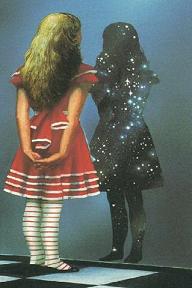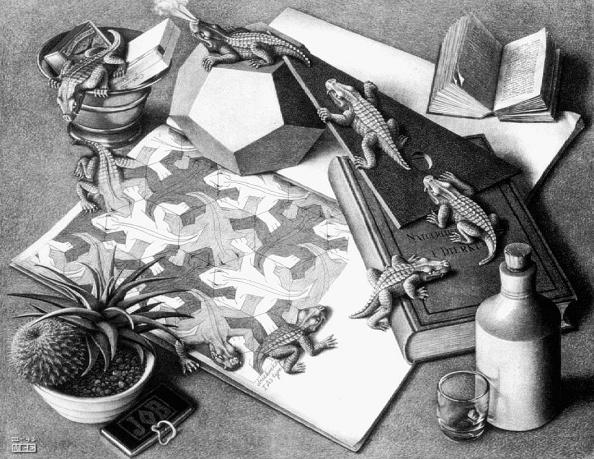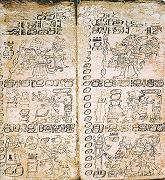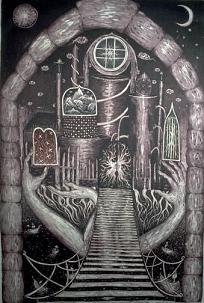The Ancient Art of Arkhelogy: The Importance of the Core Self and Core Writing
[Note: This is the third part in a seven-part series.]
PART THREE: Some Principles of the Ancient Art of Arkhelogy
The practice of Arkhelogy is built on certain underlying premises:
(1) Writing Takes Place in the Subconscious
Some people view the subconscious as merely a dumping ground for stuff the conscious mind cannot or does not want to handle. Others consider that the subconscious only exists for people who have “problems.” They think that if you are healthy, your subconscious will just fall into line with your conscious mind. None of these ideas are true.
The subconscious actually operates – in everyone -- as an independent mind. It perceives, processes, and retains things that never enter the conscious mind at all.

We all have material in the subconscious. In fact, it is where nearly all our material is found, but it cannot gather itself together, emerge, and become part of a work of art unless the conscious mind allows it. If the conscious mind is not ready, there will be no reason for information contained in the subconscious to be absorbed into consciousness or permitted to emerge.
Because conscious objectives are often diametrically opposed to those of the subconscious, the conscious mind usually acts as a suppressor.
However, it is possible to move the conscious mind gradually towards taking the part of
conjurer and collaborator, rather than suppressor, asking for material from the subconscious rather than blocking it, and as a bridge for that material to pass into the linear, daytime world and find expression in a concrete product. This is part of what the Archetypes approach does.
One’s Own Writing
So, why do I say that one’s own writing takes place in the subconscious? Of course we can all write consciously. We can sit down to write a report or a letter to the editor and say what we think needs to be said. Obviously, I am talking about another kind of writing, am I not? I am talking about your writing. I’m talking about your subject, your characters, your story: what belongs to you and no one else. These all reside in your subconscious. They already exist and you already “know” them, but at the same time, you don’t know them, you may search for others to tell you how to find them, how to write the novel or screenplay you want to write, how to tell your story. As Proust wrote in The Captive: “Every artist is a native of an unknown country, which he himself has forgotten . . . but remains all his life attuned to it” (Marcel Proust, The Captive, Andreas Mayor, transl. (Vintage, 1971), pp. 347-48).
Part of the reason why people both know and don’t know their own subjects is the principle that you must find outside material to substantiate everything inside of you. We’ll discuss this momentarily. The other part of the reason is simply that it’s in your subconscious. Things can emerge from and disappear back into the subconscious, like ghosts.
There are several parts of the Archetypes Approach that utilize the principle of subconscious jurisdiction over your writing – and indeed the entire approach is based on this premise, but the exercise that is intended most directly to teach the student how it works, in a kind of real-time way, is the “UoD” (or Universes of Discourse) exercise. This exercise requires you to watch “UoD movies” from a special movie list. Each of the movies on the list has two “universes of discourse” which work in a similar fashion as the conscious and subconscious.
(2) Your Characters Already Exist Within You, But The Material Exists Outside of You

Your characters are already there inside of you but you don’t know them fully yet. Once you find an example outside of you of part of one of your characters, you’ll instantly recognize it as somehow yours, and the additional outside factual material will fill in and flesh out the character inside.
I could speculate why or how it is that people’s characters already exist in them, but it is not necessary. It may have to do with the psychological principle of internalization of parental and other forces on one as a child. This would explain how it is that our characters already exist in us but are not fully formed, since children may not yet discern all the details or nuances inherent in the actions of parents or caregivers, even while they deeply experience the effects of those actions on them. In this way, one’s characters are simply the people who had the most effect on one’s early life. And further, because as a child one only absorbed the archetypal outlines of these characters, it is the archetype itself that needs to be retrieved and filled in.
Whatever the reasons for why characters exist inside of us and are discoverable through archetype work, the fact has great consequences for writing and it is a major underlying premise of the archetype approach.
(3) Certain Activities Promote Your Writing
More than time spent writing, more than novel- or screen-writing classes, more than advice from established writers or editors, there is a certain set of activities, not apparently related to writing, that will enable your own writing to happen of its own accord.
As usual, these activities are challenging to do. The reason why is because the activities change your entire way of looking at things, yourself and your life, your entire way of relating, of living. It is a more powerful and empowering way to use yourself and your life, but the fact remains that if it is your writing that you want to do, these activities are essential.
 |
(4) Story Arises Out of Character
 |
Character archetypes, when combined, form story archetypes. The story arises from the ways in which the character archetypes interact. Ultimately, this means that there are story archetypes, too, but these are found only through working with character archetypes.
It is possible to reach one’s own writing through other approaches. Students can benefit from studying characterization techniques, story structure, or Jungian-type archetypes. However, Arkhelogy supplies a major missing link which is not addressed by these other techniques .
The archetypes for writers approach is a travel guide for the tangled woods of an intimate personal journey, a tool for training the dual mind, and a method of construction of that for which the hero’s journey and story structure provide blueprints: characters and stories.
(5) In order for you to write your own writing, there must be at least one other person who recognizes your real own writing and wants you to do it.

(6) You are naturally drawn to your subject matter and the process of finding and working with your subject matter is a healing and transforming process.

Learning to listen to your subconscious is part of this journey. When you do learn to listen to your subconscious, you’ll find that it will lead you. There are many barriers to doing this work. This method is designed to help you navigate around those barriers and learn to listen to your deep Self.
(7) One’s own writing is an expression of the Self and thus all work that enables one’s own writing must be to organize one’s daily life to enable Self-expression.

It is not merely about sitting down and writing. Whatever you do to enable the expression of your Self will enable your writing.
In part four, we discuss the mechanical exercises. It should be understood that while these exercises teach the component skills of Arkhelogy, as well as introducing how the skills eventually integrate into the global skill of “doing archetypes,” neither the sum of the component skills nor the mere inclusion of a discussion of how they integrate will “add up” to the Arkhelogy skill. Just as a breakdown and discussion of how to ride a bike cannot teach you how to ride one, Arkhelogy cannot be learned by simply reading about it and adding up its parts. Part four of this series, therefore, is meant only as a bare outline for purposes of introduction and discussion.
(8) Writing connects one with forces greater than oneself.

Writing is not only about getting in contact with your subconscious or deep Self; it is also about coordinating oneself with that which surrounds oneself. It means accepting and working with the world as it is. Human events and conditions are shaped by many things: the push and pull of collective and individual human desires, physical laws and forces, the force of life around us, personal and collective history, and so on. Ultimately, writing is about everything, not just human interactions. And ultimately, because writing focuses us on things both within and without ourselves, those things become incorporated into our work.
Because of this, writing is greater than any individual. While the self is not lost and selfish drives are not dissolved, the writing is for something other than self gain. Considerations of “the greater good” may or may not arise, but they must exist if the writing is to be anything more than merely personal and autobiographical – that is, if it is to become universal.
___________________________________________________________________________________
PART ONE: Arkhelogy: A Gateway to the Self
PART TWO: The Archetypal – The Eternal & Eye of the Soul
PART FOUR: The Arkhelogy Program
PART X: The Arkhelogy Skill: Lost in Time
PART SIX: International High School Writing Programs
PART SEVEN: An Arkhelogy Program for International Schools
___________________________________________________________________________________

Jennifer Van Bergen is an author, educator, and environmentalist currently living in Gainesville, Florida, where she teaches English and Law at Sante Fe College. Van Bergen is a former faculty member of the New School University in NYC, where she taught a course in the Writing Program that she eventually developed into her book Archetypes for Writers: Using the Power of Your Subconscious. Van Bergen is also the author of The Twilight of Democracy: The Bush Plan for America. She has also published several scholarly law articles, including one on the 1801 electoral tie between Thomas Jefferson and Aaron Burr, here. [ jennifer.vanbergen@gmail.com ]
___________________________________________________________________________________


























